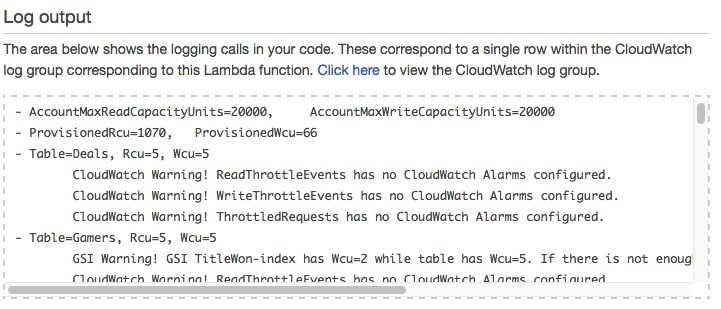import boto3
import json
import logging
from datetime import datetime
def lambda_handler(event, context):
settings = Settings()
#Set region
region = 'us-east-1'
if settings.region:
region = settings.region
#Init Clients
ddbClient = boto3.client('dynamodb', region_name=ddbRegion)
cloudWatchClient = boto3.client('cloudwatch', region_name=region)
#New account object
account = Account()
#Get account limits
account_limits(dynamoDBClient, account)
#Get details for all tables in account
account_tables(dynamoDBClient, cloudWatchClient, account, settings)
#Analyse account object, print report and generate number of warnings
warnings = generateReport(account, settings)
#Add warnings as custom cloud watch metric if enabled in settings
if(settings.addCustomMetric == 1):
addWarningAsCustomCloudWatchMetric(cloudWatchClient, settings, warnings)
#Print warning count
message = str(warnings) + ' warning(s) found.View Log output below or go to CloudWatch log group to see detailed report.'
return message
##############################################
#Add warning count as custom cloud watch metric
def addWarningAsCustomCloudWatchMetric(cloudWatchClient, settings, warnings):
#Add custom metric to CloudWatch if enabled in settings
cloudWatchClient.put_metric_data(
Namespace=settings.customMetricNamespace,
MetricData=[
{
'MetricName': settings.customMetricName,
'Value': warnings,
},
]
)
##############################################
# Analyse account and generate report
def generateReport(account, settings):
warnings = 0
print('DynamoDB analysis report...')
#Print Limits and Provisioned Capacity
print('- TableMaxReadCapacityUnits=%s,\t TableMaxWriteCapacityUnits=%s' % (account.tableRcuLimit , account.tableRcuLimit))
print('- AccountMaxReadCapacityUnits=%s,\t AccountMaxWriteCapacityUnits=%s' % (account.accountRcuLimit, account.accountWcuLimit))
print('- ProvisionedRcu=%s,\t ProvisionedWcu=%s' % (account.provisionedRcu, account.provisionedWcu))
#Warn on RCU account limit alert
if(account.provisionedRcu >= (settings.accountLimitAlertLevel/100.0)*account.accountRcuLimit):
print('\tRCU Limit Alert! Current provisioned RCU (%s) is %s %% of current account limit of %s.You have set warning threshold to %s%%.' % \
(account.provisionedRcu, (100.0*account.provisionedRcu/account.accountRcuLimit), account.accountRcuLimit, settings.accountLimitAlertLevel))
warnings += 1
#Warn on WCU account limit alert
if(account.provisionedWcu >= (settings.accountLimitAlertLevel/100.0)*account.accountWcuLimit):
print('\tWCU Limit Alert! Current provisioned WCU (%s) is %s %% of current account limit of %s.You have set warning threshold to %s%%.' % \
(account.provisionedWcu, (100.0*account.provisionedWcu/account.accountWcuLimit), account.accountWcuLimit, settings.accountLimitAlertLevel))
warnings += 1
for table in account.tables:
print('- Table=%s, Rcu=%s, Wcu=%s' % (table.name, table.rcu, table.wcu))
#Table RCU Warnings
if(table.totalRcu >= (settings.accountLimitAlertLevel/100.0)*account.tableRcuLimit):
print('\tRCU Limit Alert! Current provisioned RCU (%s) of table is %s %% of current table-max account limit of %s.You set warning threshold to %s%%.' % \
(table.totalRcu, (100.0*table.totalRcu/account.tableRcuLimit), account.tableRcuLimit, settings.accountLimitAlertLevel))
warnings += 1
#Table WCU Warnings
if(table.totalWcu >= (settings.accountLimitAlertLevel/100.0)*account.tableWcuLimit):
print('\tWCU Limit Alert! Current provisioned WCU (%s) of table is %s %% of current table-max account limit of %s.You set warning threshold to %s%%.' % \
(table.totalWcu, (100.0*table.totalWcu/account.tableWcuLimit), account.tableWcuLimit, settings.accountLimitAlertLevel))
warnings += 1
#GSI Warnings
for gsi in table.gsi:
if(gsi.gsiWarning == 1):
print('\tGSI Warning! GSI %s has Wcu=%s while table has Wcu=%s.If there is not enough Wcu provisioned for GSI it can throttle table.' % \
(gsi.name, gsi.wcu, table.wcu))
warnings += 1
#CloudWatch Alarm Warnings
for cwm in table.cloudWatchMetrics:
if(len(cwm.cloudWatchAlarms) == 0):
print('\tCloudWatch Warning! %s has no CloudWatch Alarms configured.' % cwm.name)
warnings += 1
else:
for cwa in cwm.cloudWatchAlarms:
if(cwa.hasActionsEnabled == 0):
print('\tCloudWatch Warning! alarm %s for metric %s has no action configured.' % (cwa.name, cwm.name))
warnings += 1
return warnings
##############################################
#Get limits
def account_limits(client, account):
response = client.describe_limits()
account.tableRcuLimit = response.get('TableMaxReadCapacityUnits')
account.tableWcuLimit = response.get('TableMaxWriteCapacityUnits')
account.accountRcuLimit = response.get('AccountMaxReadCapacityUnits')
account.accountWcuLimit = response.get('AccountMaxWriteCapacityUnits')
##############################################
#Get tables
def account_tables(client, cloudWatchClient, account, settings):
response = client.list_tables()
tables = response.get('TableNames')
for table in tables:
odt = DynamoDBTable()
analyse_table(client, cloudWatchClient, table, odt, settings)
account.provisionedRcu += odt.totalRcu
account.provisionedWcu += odt.totalWcu
account.tables.append(odt)
##############################################
#Analyse tables and nested objects of each table
def analyse_table(client, cloudWatchClient, tableName, table, settings):
response = client.describe_table(TableName=tableName)
json.dumps(response, default=date_handler)
table.name = tableName
table.totalRcu = table.rcu = response['Table']['ProvisionedThroughput']['ReadCapacityUnits']
table.totalWcu = table.wcu = response['Table']['ProvisionedThroughput']['WriteCapacityUnits']
if('GlobalSecondaryIndexes' in response['Table']):
gsis = response['Table']['GlobalSecondaryIndexes']
for gsi in gsis:
ogsi = DynamoDBGsi()
ogsi.name = gsi['IndexName']
ogsi.rcu = gsi['ProvisionedThroughput']['ReadCapacityUnits']
ogsi.wcu = gsi['ProvisionedThroughput']['WriteCapacityUnits']
table.totalRcu += ogsi.rcu
table.totalWcu += ogsi.wcu
if(ogsi.wcu != table.wcu and ogsi.wcu < ((settings.gsiThroughputAlertLevel/100.0)*table.wcu)):
ogsi.gsiWarning = 1
ogsi.gsiWarningDiff = table.wcu - ogsi.wcu
table.gsiWarning = 1
table.gsi.append(ogsi)
checkCloudWatchAlarmsForTable(table, cloudWatchClient)
##############################################
#Check CloudWatchAlarms for Table
def checkCloudWatchAlarmsForTable(table, cloudWatchClient):
checkCloudWatchAlarmForMetric(cloudWatchClient, table, 'ConsumedReadCapacityUnits')
checkCloudWatchAlarmForMetric(cloudWatchClient, table, 'ConsumedWriteCapacityUnits')
checkCloudWatchAlarmForMetric(cloudWatchClient, table, 'ReadThrottleEvents')
checkCloudWatchAlarmForMetric(cloudWatchClient, table, 'WriteThrottleEvents')
checkCloudWatchAlarmForMetric(cloudWatchClient, table, 'ThrottledRequests')
#Check CloudWatchAlarms for each metric
def checkCloudWatchAlarmForMetric(client, table, metricName):
response = client.describe_alarms_for_metric(
Namespace='AWS/DynamoDB',
MetricName = metricName,
Dimensions=[
{
'Name': 'tablename',
'Value': table.name
},
]
)
cloudWatchMetric = CloudWatchMetric()
cloudWatchMetric.name = metricName
metricAlarm = response.get('MetricAlarms')
metricAlarmCount = len(metricAlarm)
#Check if each alarm is properly configured
if(metricAlarmCount > 0) :
for m in range(0, metricAlarmCount) :
cwAlarm = CloudWatchAlarm()
cwAlarm.name = response.get('MetricAlarms')[m].get('AlarmName')
if(response.get('MetricAlarms')[m].get('ActionsEnabled') == True):
cwAlarm.hasActionsEnabled = 1
cloudWatchMetric.cloudWatchAlarms.append(cwAlarm);
table.cloudWatchMetrics.append(cloudWatchMetric)
##############################################
def date_handler(obj):
if hasattr(obj, 'isoformat'):
return obj.isoformat()
else:
raise TypeError
############ Class definitions #################
class Account:
tableRcuLimit = 0
tableWcuLimit = 0
accountRcuLimit = 0
accountWcuLimit = 0
provisionedRcu = 0
provisionedWcu = 0
def __init__(self):
self.tables = []
class DynamoDBTable:
name = ''
rcu = 0
wcu = 0
totalRcu = 0
totalWcu = 0
gsiWarning = 0
def __init__(self):
self.gsi = []
self.cloudWatchMetrics = []
class CloudWatchMetric:
name = ''
def __init__(self):
self.cloudWatchAlarms = []
class CloudWatchAlarm:
name = ''
hasActionsEnabled = 0
class DynamoDBGsi:
name = ''
rcu = 0
wcu = 0
gsiWarning = 0
gsiWarningDiff = 0
class Settings:
#AWS region
region = 'us-west-2'
#Generate warning if provisioned throughput is more than x% of account limit
accountLimitAlertLevel = 50
#Generate warning GSI has throughput less than x% of the table's throughput
gsiThroughputAlertLevel = 50
#Add warnings to CloudWatch as custom metric
addCustomMetric = 0
customMetricNamespace = 'kashif'
customMetricName = 'DynamoDBAuditWarnings'
 [Log output] で出力内容の詳細を表示できます。大量の警告がある場合、すべての警告が [Log output] に表示されないことがあります。この機能の完全な出力結果を得るには、[Click here] のリンクを選択し、[Log output] の下にある CloudWatch ロググループを表示します。
[Log output] で出力内容の詳細を表示できます。大量の警告がある場合、すべての警告が [Log output] に表示されないことがあります。この機能の完全な出力結果を得るには、[Click here] のリンクを選択し、[Log output] の下にある CloudWatch ロググループを表示します。 Lambda 関数のコードには、警告を生成する AWS リージョンや閾値など、さまざまなパラメータを指定できます。次のコードブロックは、これらのパラメータを提供する方法を示しています。
Lambda 関数のコードには、警告を生成する AWS リージョンや閾値など、さまざまなパラメータを指定できます。次のコードブロックは、これらのパラメータを提供する方法を示しています。 Josh Kahn 氏は、Amazon Web Services のソリューションアーキテクトです。同氏は AWS の顧客と協力し技術指導や設計アドバイスを提供しています。また、同氏の専門知識は、アプリケーションアーキテクチャー、サーバーレス、コンテナ、NoSQL 、機械学習にまで多岐にわたります。
Josh Kahn 氏は、Amazon Web Services のソリューションアーキテクトです。同氏は AWS の顧客と協力し技術指導や設計アドバイスを提供しています。また、同氏の専門知識は、アプリケーションアーキテクチャー、サーバーレス、コンテナ、NoSQL 、機械学習にまで多岐にわたります。